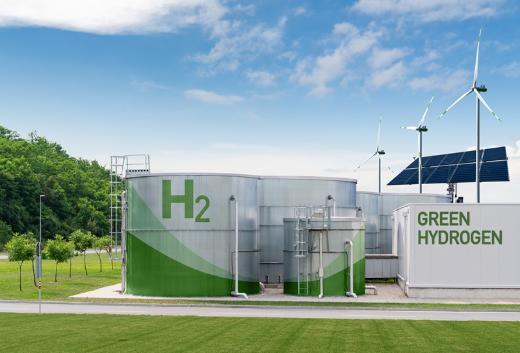Can sea water power the future of green hydrogen?
Thursday, 14 November, 2024
Climate change is having a major impact across Europe. The European Drought Observatory has reported that (opens in a new window)nearly 50% of the continent is under drought warning with (opens in a new window)southern European countries having already in place severe water restrictions. So where does the green hydrogen economy sit in all of this, asks (opens in a new window)Veronica Sofianos (UCD School of Chemical and Bioprocess Engineering)?

Green Hydrogen factory concept. Hydrogen production from renewable energy sources. Credit: (opens in a new window)iStock.
Hydrogen is considered an attractive energy vector due to its high energy-to-mass ratio of 120 MJ/kg that can easily replace fossil fuel consumption and meet global energy demands. When produced from renewable energy, it is referred as ‘green’ hydrogen.
Currently the main technology used for the production of green hydrogen is water electrolysis, also known as electrochemical water splitting. In this process electricity is used to split water into hydrogen and oxygen gas. However, fossil fuels such as natural gas, coal or biomass gasification are still the main technologies for producing hydrogen on an industrial scale, occupying 96% of hydrogen production. Only the remaining 4% is green hydrogen.
So, why is that? This question can be very easily answered in a single word ‘cost’. Currently, the devices used to split water into hydrogen and oxygen gas, also known as electrolysers, are both too expensive to manufacture and too expensive to run. The electrodes used in the current state-of-the-art electrolysers are made out of two rare and incredibly expensive metals, platinum and ruthenium.
To make matters worse, the efficiency of the actual electrolyser can vary from 57% to 80%, with a maximum lifetime of 20,000 hours, and if not continuously used, its overall system lifetime can reach 10 to 20 years. Additionally, we would need nine kilograms of ultra-pure water to produce just one kilogram of hydrogen if the electrolyser was operating with 100% efficiency. This does not exist so in reality we need between eleven and thirteen kilograms of water to produce just one kilogram of hydrogen. Bearing all this in mind, it is just easier and cheaper to use fossil fuels to produce hydrogen, which totally defeats its green credentials.
So how can the green hydrogen economy flourish? Especially when water scarcity is a reality and green hydrogen is competing for these precious resources, putting both energy supply and water availability at risk, especially during periods of drought?
Instead, we need new technologies for the production of cheap hydrogen through water electrolysis using directly low-grade water, such as seawater. This is vitally important if we want the green hydrogen economy to flourish and to contribute towards decarbonising the energy sector.

Henrique Craveiro on (opens in a new window)Unsplash
The advantages of using sea water are plentiful. Sea water is highly abundant – providing 97% of the Earth’s water resources in comparison to a mere 3% being freshwater. Sea water is often located in close proximity to many major urban centres and/or energy infrastructure. Additionally, energy intense desalination units are not required in the production of hydrogen using sea water resulting in a more compact design with fewer system engineering challenges, lower capital costs, less maintenance, and smaller required space.
However, the limitations of sea water in the production of hydrogen also offer many challenges. Sea water contains up to 3.5 wt% salts in the presence of various metal ions which often react with the cathode, contributing to electrode corrosion and poor overall performance. Additionally, bacteria, microorganisms, microplastics and other non-identified impurities in sea water may participate in competing reactions to water electrolysis, negatively effecting the overall efficiency of the electrolyser. Lastly, the high concentration of chloride ions in seawater often affects both the anode and the cathode. At the cathode, chloride ions can block the electrode’s surface and therefore result in degrading performance. At the anode significant amounts of chlorine or hypochlorites can be generated.
The complexity of direct seawater electrolysis has limited our complete understanding on how electrolysers can be designed and upscaled for the most efficient mass production of cheap green hydrogen, giving the deserved space to the hydrogen economy to flourish. Direct seawater electrolysis may be science fiction at the moment but it has great potential to be science reality tomorrow, that is with the constant effort of the scientific community to tackle this challenge. Just watch the space!
About the author
(opens in a new window)Veronica Sofianos is a Materials Scientist with a PhD in Chemistry. She was awarded a prestigious scholarship from the National Centre of Scientific Research "Demokritos" in Athens, Greece, to conduct a PhD on nanomaterials for photocatalytic air purification. Her PhD dissertation was awarded as "Best Thesis" for 2014 across the centre. She was a casual academic for one semester at the University of Melbourne in Australia and then took up a research academic position at Curtin University in Perth, Australia. As a Research Fellow at Curtin she focused on the synthesis and characterisation of metal hydrides for hydrogen storage either for vehicular or high-temperature applications promoting green growth and the hydrogen economy. She joined the UCD School of Chemical and Bioprocess Engineering as an Ad Astra Fellow.
Further reading
EU Science Hub: (opens in a new window)Variable drought conditions keep affecting large parts of Europe, new report shows
Martin Kuebler, (opens in a new window)Can rivers and lakes recover from drought?
Tim Schauenberg, (opens in a new window)EU countries restrict drinking water access